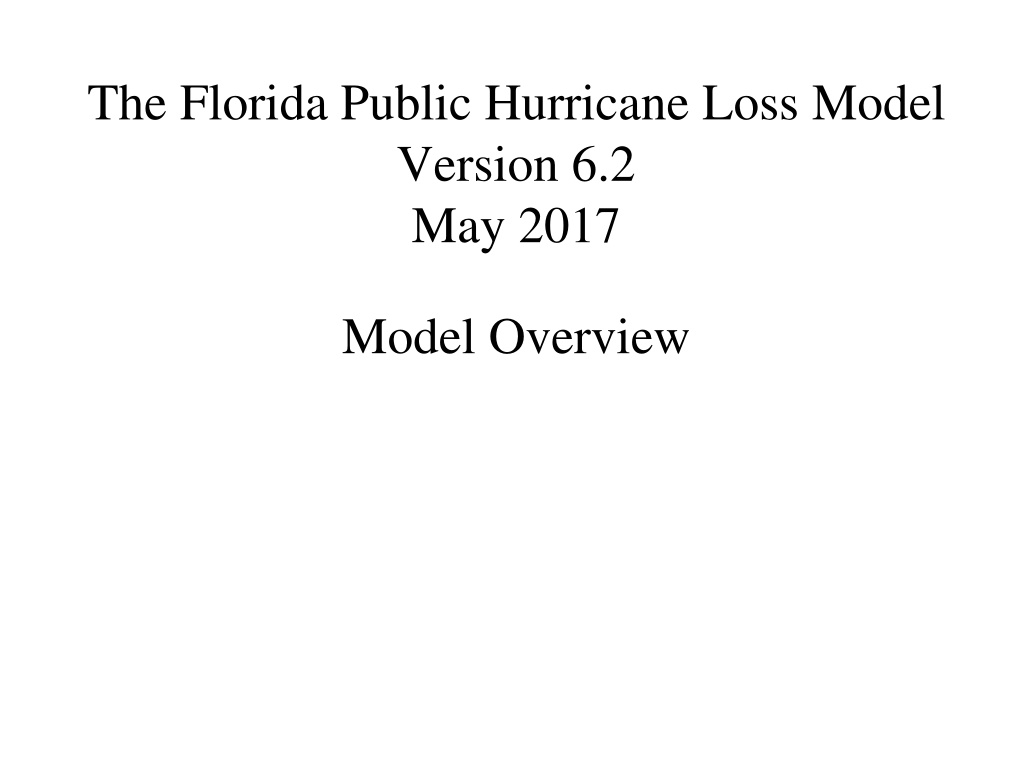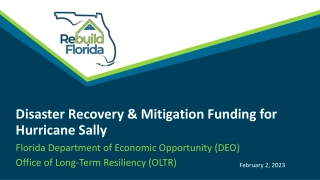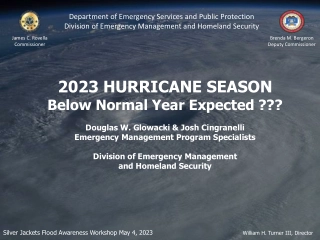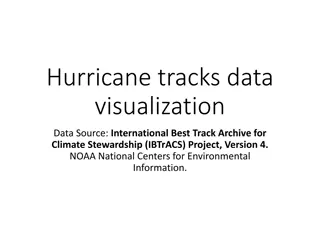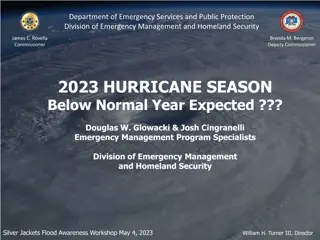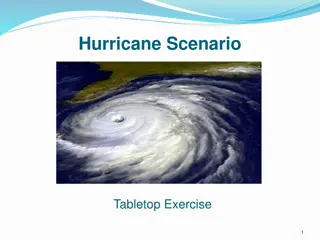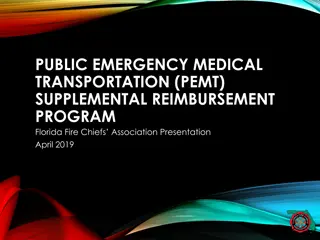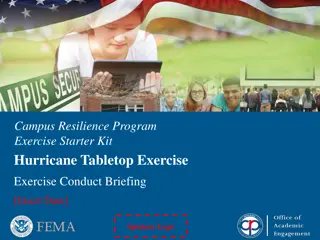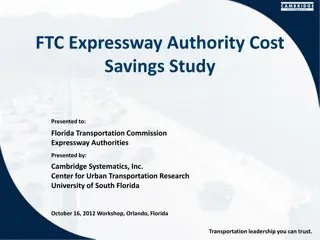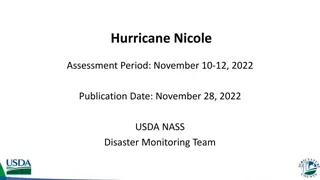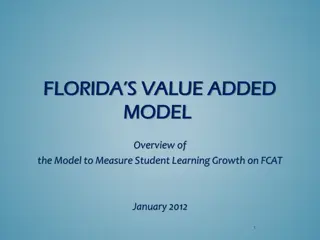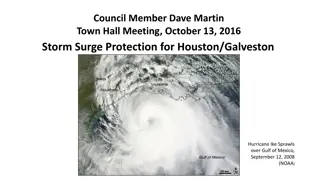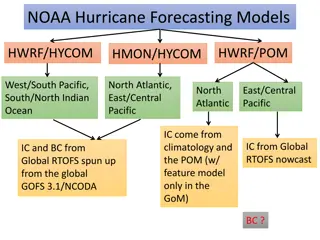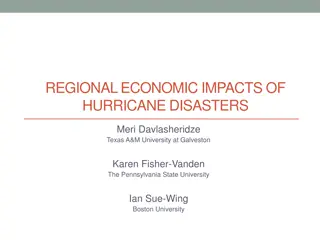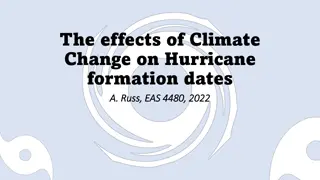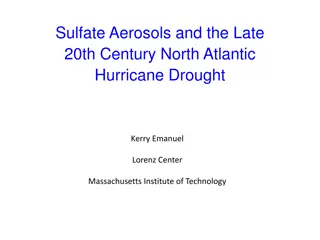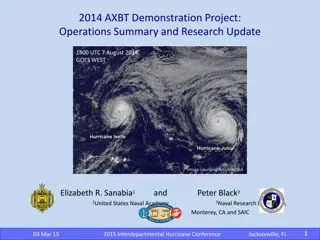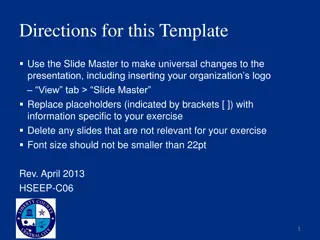Florida Public Hurricane Loss Model Overview
The Florida Public Hurricane Loss Model, developed by a team of experts at Florida International University, provides hurricane modeling services to insurance industry clients. Since its first activation in 2006, the model has seen several updated versions accepted by the Florida Commission on Hurricane Loss Projection Methodology. The development project was funded by the FL-Office of Insurance Regulation, and technical reports and other documentation are available for transparency. Participating institutions include Florida International University, Florida State University, and others.
- Hurricane modeling
- Florida Public Hurricane Loss Model
- Insurance industry
- Florida International University
- Risk assessment
Download Presentation

Please find below an Image/Link to download the presentation.
The content on the website is provided AS IS for your information and personal use only. It may not be sold, licensed, or shared on other websites without obtaining consent from the author. Download presentation by click this link. If you encounter any issues during the download, it is possible that the publisher has removed the file from their server.
E N D
Presentation Transcript
The Florida Public Hurricane Loss Model Version 6.2 May 2017 Model Overview
The FPHLM development project for personal and commercial residential properties was funded by the FL-Office of Insurance Regulation. We are currently funded to operate, update and maintain the model at Florida International University. Model is operated by a team of experts in computer science, actuarial science, finance, statistics, meteorology and engineering.
Our major client is the FL-OIR Since 2009, as required by the Florida legislature, we have provided hurricane modeling services to over thirty clients in the insurance industry. Model development was not influenced by either FL-OIR or the insurance industry
The model was first activated in March 2006. This version was used to process the insurance company data on behalf of the Florida Office of Insurance Regulation. In Summer 2007 a revised and updated version 2.6 of the model was accepted by the Florida Commission on Hurricane Loss Projection Methodology and put to immediate use. Another revised and updated version 3.0 was accepted by the Commission in June 2008. Another revised and updated version 3.1 was accepted by the Commission in June 2009. Version 4.1 and 5.0 were accepted by the Commission in Summer 2011 and Summer 2013 respectively. The latest version 6.1 was accepted by the Commission in Summer 2015 and is in use.
General Comments The model is transparent in the sense that we make available technical reports, flowcharts etc. on the assumptions, methods, theories, component designs, and tests. In fact much has already been published in refereed journals and proceedings. Technical documents are available at the project website: www.cis.fiu.edu/hurricaneloss/ The source code, however, is not open.
Participating Institutions Florida International University/ IHRC (lead institution) Florida State University Florida Institute of Technology University of Florida University of Miami Hurricane Research Division, NOAA AMI Risk Consultants
University of Miami (UM) Florida State University (FSU) Office of Insurance Regulation (OIR) Funding Agency Clients National Oceanic and Atmospheric Administration Hurricane Division (NOAA/HRD) Florida International University (FIU) Lead University University of Florida (UF) Insurance Companies - clients Florida Institute of Technology (FIT)
About 18 professors and experts and a dozen student assistants were involved in the development and operation of the model.
Current Meteorology Team Dr. Steven Cocke Dept of Meteorology, FSU Team leader Dept of Meteorology, FSU University of Miami CIMAS Hurricane Research Division, NOAA Dr Dong-Wook Shin Bachir Annane Neal Dorst
Current Engineering Team Dr. Jean Paul Pinelli* Dept of Civil Engineering, FIT Team leader Dept of Civil Eng, UF Dr. Kurtis Gurley Graduate students
Actuarial/Finance Team Dr. Shahid Hamid* Dept of Finance and IHRC, FIU PI and Project Director Actuary, FCAS, AMI Risk Consultant Actuary, FCAS, AMI Risk Consultant Actuary, FCAS, AMI Risk Consultant Gail Flannery Bob Ingco Nino Joseph Paz
Computer Science Team Dr. Shu-Ching Chen* School of Computer Science, FIU Co-PI and team leader Dept. of Electrical and Computer Engineering, University of Miami Computer scientist at IHRC, FIU Computer Scientist at IHRC, FIU Computer Scientist at IHRC, FIU Computer Science expert, consultant PhD candidate in CS at FIU PhD candidate in CS at FIU PhD student in CS at FIU PhD student in CS at FIU MS student in CE at UM Dr. Mei-Ling Shyu Dr. Hisn-Yu Ha Raul Garcia Diana Machado Dr. Fausto Fleitis Haiman Tian Samira Poutanfar Maria Presa Reyes Shen Guan Yudong Tao Other graduate and undergraduate students
Statistics Team Dr. Sneh Gulati* Dr. G. Kibria Dept. of Statistics, FIU Dept. of Statistics, FIU
Publications The project team has generated over five dozen papers. Some of these have been published in top science, engineering and computer science journals and proceedings and conferences. Some of the publication outlets are: - Nature - ASCE Journal of Structural Engineering - Software Practice and Experience - Natural Hazard Review - Numerous IEEE Proceedings - Journal of Wind and Industrial Engineering Aerodynamic - Intl Wind Engineering Proceedings - Reliability Engineering and System Safety Journal
Publications (continued) - Government Information Quarterly - Statistical Methodology - Statistical proceedings of ASA - Wind and Structures - Journal of Risk and Uncertainty in Engineering Systems - Theoretical and Applied Climatology - Various Meteorology conferences - Numerous engineering conference proceedings
Model Design The model consists of three major components: wind hazard (meteorology), vulnerability (engineering), and insured loss cost (actuarial). The major components were developed independently before being integrated. The computer platform is designed to accommodate future hookups of additional sub- components or enhancements.
User Input Storm Forecast Module Retrieves historical storm data set based on user input Generates probability distribution functions for storm motion and intensity Generates initial conditions for the storms Generates storm tracks for simulated storms Historical Storm Database: HURDAT Stochastic Storm Database: Simulated Storms Wind Field Module Estimates open terrain wind speeds Generates actual terrain wind speeds by using roughness data and gust factors Calculates probability of 3-sec gust wind speeds Information from Geo Database: Ground Elevation and Exposure Classification Engineering Vulnerability Module Building Stock Data Defines structural type Translates and loads wind speeds Quantifies wind resistance Performs Monte Carlo simulation for external damage Quantifies total damage Engineering Data Actuarial Loss Module Policy Data Loads winds and vulnerability matrices Adds demand surge factors Calculates probability based insurance loss costs Calculates scenario based insurance loss costs Insurance Claims Data Output
In 2013 the state funded FIU to enhance the FPHLM by adding both a storm surge and fresh water flooding component. The proto type for the flood component will be ready this year.
